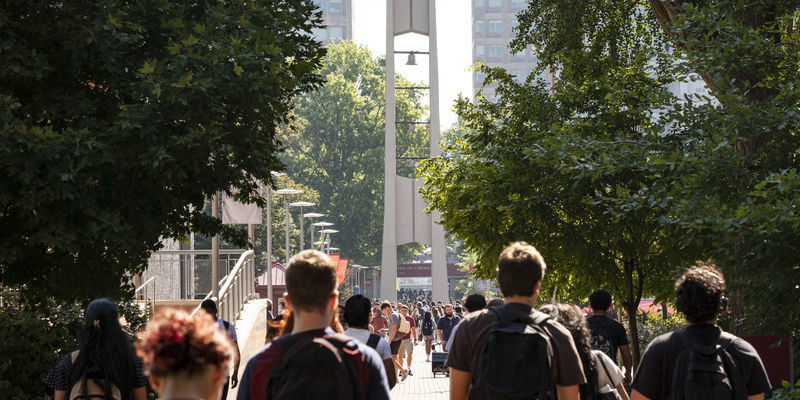A primer on Temple’s operating budget
As enrollment challenges continue to impact universities and colleges across the Northeast, Temple University is working to ensure that the university remains on a sustainable path moving forward.

Temple University’s operating budget—which finances the day-to-day, ongoing operations of the university—is almost entirely driven by tuition revenue.
The other primary driver for the operating budget is the nonpreferred appropriation from the commonwealth, which has remained flat for the last four years at $158.2 million while all operating costs, such as utilities, salary/benefits and insurance, have increased. Unfortunately, the university’s appropriation for this year has not yet been approved in Harrisburg.
The uncertainty of the appropriation, together with inflation and a decrease in enrollment, have combined to create a perfect storm of strain on the university’s budget.
“Like so many other universities and colleges in this part of the country, we knew that the enrollment cliff was coming, and this was something that we spent years preparing for,” said Jaison Kurichi, associate vice president for budget. “The challenge is that a number of other factors, like the COVID-19 pandemic and the multiple years of flat state funding, really further exacerbated our budgetary challenges.”
This year, Temple’s total enrollment is 30,530, but just six years ago, in the fall of 2017, the total was 40,240. This decline of nearly 10,000 students translates to a reduction of approximately $200 million in gross tuition.
And while the university’s enrollment has decreased by 24.1% students since the fall of 2017, its number of full- and part-time time faculty members has decreased by only 3.5%, down to 3,671 from 3,804.
“From an enrollment standpoint, we’re back to where we were in 2002. But the expense structure is still in line with what we had when we were at 40,000 students because our number of faculty members hasn’t really changed,” said David Marino, vice president of finance and treasurer. “We have eliminated administrative positions by not filling staff vacancies, but through and since the pandemic, we have never considered or pursued mass layoffs across the university.”
Declining enrollment has a compounding effect on the university’s budget challenges because of the other ways in which it affects the university’s operations. While tuition and the appropriation support more than 84% of Temple’s operating budget, revenue generated by the the university’s other departments is also down because of its relationship to enrollment.
“There’s a ripple effect across the university because we have the smaller class. There are so many other services that we’re investing in that then aren’t used optimally. For example, we have had to cut back on on-campus dining options because we now have fewer students,” Kurichi said.
Compensation and benefits make up the majority of overall operating expenses, which has created additional challenges.
“The primary source of revenue is your tuition revenue, and the primary expense that matters is your labor cost. So when we were at 40,000 students compared to 32,000 or 30,000, we had about $200 million more revenue,” Marino said. “That labor cost is still there and with cost of living adjustments, it has actually gone up. So that’s where we have lost correlation now.”
In recent years, Temple has received one-time financial support from the federal government. Many of these funds have been Higher Education Emergency Relief Funds (HEERF) that were distributed in the wake of the COVID-19 pandemic and had to be used for specific purposes like student financial aid. Even when these kinds of funds are unrestricted, their one-off nature means they cannot support the ongoing operating budget.
“It’s great to have nonrecurring money, but it only solves a one-time issue,” Kurichi said. “We cannot use nonrecurring dollars to pay for recurring expenses that will be here next year. You can use one-time money in the moment to bridge a gap, but somewhere along the way, there’s going to be a deficit that you have to fill, and that’s going to have to be filled by recurring dollars.”
The nonrecurring funds helped the university avoid a deficit in recent years, but those funds are no longer available. Temple began the current fiscal year with a projected $90 million budget deficit. The university has since balanced the budget projection through the elimination of more than 150 administrative staff vacancies and the planned use of reserves.
Additional budget challenges could be ahead. The number of college-going students is expected to continue to decline in the Northeast. As a result, Temple President Richard Englert has identified enrollment as one of the key priorities that Temple will continue to focus on during his presidency.
“What you have to remember is that even though Temple has to be tight with regard to its budget right now, this university is not going anywhere,” Englert said. “This university is still more than 30,000 students strong, and is going to continue to thrive well into the future. We want to give even more students the opportunity to engage with our world-class faculty.”
Temple is in the process of pursuing a reinvigorated enrollment strategy, grounded in what makes Temple distinctive and telling that story in the most effective way possible. New Vice Provost for Enrollment Management Jose Aviles has a number of additional enrollment strategies and initiatives that are currently in development. The university is also working on a refreshed strategic plan that will continue to push Temple forward.
“We grew tremendously for 20 years, and then we saw that growth go away,” Marino said. “And now, we have to adjust to this new reality that we’re smaller than we were seven years ago. That’s where it is so important that we’re thoughtful and deliberate in making the key decisions that will continue to keep us sustainable and thriving for years to come.”


